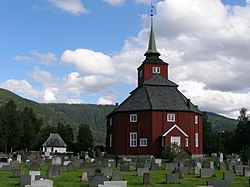Støren (municipality)
Støren herred | |
|---|---|
 View of the local church | |
 Sør-Trøndelag within Norway | |
 Støren within Sør-Trøndelag | |
| Coordinates: 63°02′21″N 10°17′06″E / 63.0391°N 10.2851°ECoordinates: 63°02′21″N 10°17′06″E / 63.0391°N 10.2851°E | |
| Country | Norway |
| County | Sør-Trøndelag |
| District | Gauldalen |
| Established | 1 Jan 1838 |
| Disestablished | 1 Jan 1964 |
| Administrative centre | Støren |
| Population (1964) | |
| • Total | 2,296 |
| Demonym(s) | støresbygg[1] |
| Time zone | UTC+01:00 (CET) |
| • Summer (DST) | UTC+02:00 (CEST) |
| ISO 3166 code | NO-1648 |
| Created as | Formannskapsdistrikt in 1838 |
| Succeeded by | Midtre Gauldal in 1964 |
![]() Støren (help·info) is a former municipality in the old Sør-Trøndelag county, Norway. The municipality existed from 1838 until its dissolution in 1964. The municipality was located in the north-central part of what is now the municipality of Midtre Gauldal in Trøndelag county. The administrative center was the village of Støren where Støren Church is located.[2]
Støren (help·info) is a former municipality in the old Sør-Trøndelag county, Norway. The municipality existed from 1838 until its dissolution in 1964. The municipality was located in the north-central part of what is now the municipality of Midtre Gauldal in Trøndelag county. The administrative center was the village of Støren where Støren Church is located.[2]
History[]
The prestegjeld of Støren was established as a civil municipality on 1 January 1838 (see formannskapsdistrikt). In 1841, the large municipality of Støren was divided into three municipalities: Horg in the north (population: 2,374), Støren in the east (population: 2,312), and Soknedal in the west (population: 1,966). In 1879, the southern part of Støren (population: 585) was separated to form the new municipality of Budal. This left Støren with 1,840 residents. During the 1960s, there were many municipal mergers across Norway due to the work of the Schei Committee. On 1 January 1964, the municipalities of Budal (population: 529), Singsås (population: 1,554), Soknedal (population: 1,916), and Støren (population: 2,296) were all merged to form the new municipality of Midtre Gauldal.[3]
Name[]
The municipality was named after the old Støren farm (Old Norse: Staurin), since the first Støren Church was built there. The first element is staurr' which means "pointed pole" and the last element is vin which means "meadow" or "pasture". The word staurr is probably referring to the pointed headland on which the church is located. The two rivers that form this headland are the Gaula and Sokna.[4]
Government[]
All municipalities in Norway, including Støren, are responsible for primary education (through 10th grade), outpatient health services, senior citizen services, unemployment and other social services, zoning, economic development, and municipal roads. The municipality is governed by a municipal council of elected representatives, which in turn elects a mayor.[5]
Municipal council[]
The municipal council (Herredsstyre) of Støren was made up of 17 representatives that were elected to four year terms. The party breakdown of the final municipal council was as follows:
| Party Name (in Norwegian) | Number of representatives | |
|---|---|---|
| Labour Party (Arbeiderpartiet) | 12 | |
| Conservative Party (Høyre) | 2 | |
| Centre Party (Senterpartiet) | 2 | |
| Liberal Party (Venstre) | 1 | |
| Total number of members: | 17 | |
Media gallery[]

Village of Støren (c. 1930s)

Støren Station

Haga Bridge in Støren
See also[]
References[]
- ^ "Navn på steder og personer: Innbyggjarnamn" (in Norwegian). Språkrådet.
- ^ Haugen, Morten, ed. (2017-08-30). "Støren – tidligere kommune". Store norske leksikon (in Norwegian). Kunnskapsforlaget. Retrieved 2018-01-15.
- ^ Jukvam, Dag (1999). "Historisk oversikt over endringer i kommune- og fylkesinndelingen" (PDF) (in Norwegian). Statistisk sentralbyrå.
- ^ Rygh, Oluf (1901). Norske gaardnavne: Søndre Trondhjems amt (in Norwegian) (14 ed.). Kristiania, Norge: W. C. Fabritius & sønners bogtrikkeri. p. 239.
- ^ Hansen, Tore, ed. (2016-05-12). "kommunestyre". Store norske leksikon (in Norwegian). Kunnskapsforlaget. Retrieved 2020-02-02.
- ^ "Kommunevalgene og Ordførervalgene 1959" (PDF) (in Norwegian). Oslo: Statistisk sentralbyrå. 1960. Retrieved 2020-04-20.
- ^ "Kommunevalgene og Ordførervalgene 1955" (PDF) (in Norwegian). Oslo: Statistisk sentralbyrå. 1957. Retrieved 2020-04-20.
- ^ "Kommunevalgene og Ordførervalgene 1951" (PDF) (in Norwegian). Oslo: Statistisk sentralbyrå. 1952. Retrieved 2020-04-20.
- ^ "Kommunevalgene og Ordførervalgene 1947" (PDF) (in Norwegian). Oslo: Statistisk sentralbyrå. 1948. Retrieved 2020-04-20.
- ^ "Kommunevalgene og Ordførervalgene 1945" (PDF) (in Norwegian). Oslo: Statistisk sentralbyrå. 1947. Retrieved 2020-04-20.
- ^ "Kommunevalgene og Ordførervalgene 1937" (PDF) (in Norwegian). Oslo: Statistisk sentralbyrå. 1938. Retrieved 2020-04-20.
- Midtre Gauldal
- Former municipalities of Norway
- 1838 establishments in Norway
- 1964 disestablishments in Norway





